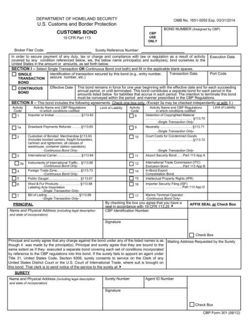How Do I Become A Bonded U.S. Highway Carrier (DIY Customs Consulting)
| This article is part of the Customs Compliance Guide |

A bonded carrier is a transportation provider that is licensed to move freight through/across U.S. points of entry (ports, border crossings) without having to pay duties, taxes and/or fees on those goods during that specific portion of their transportation. Utilizing a licensed bonded carrier allows an importer and/or consignee to transport cargo pending customs clearance until it reaches the port of entry at its destination country. In-Bond shipments are more commonly done when freight needs to be transported through the U.S. with plans to eventually move along to a foreign country.
A bonded carrier posts security with U.S. Customs and Border Protection (CBP) to cover the following situations:
- Move commercial goods to an inland airport, rail yard, seaport, CBP office or bonded warehouse.
- Move commercial merchandise or goods in transit through a U.S. corridor (such as when bringing goods in-transit through the U.S.).
- Apply to the Customs Trade Partnership Against Terrorism (CTPAT), Partners in Protection (PIP) programs and the Free and Secure Trade (FAST) Program.
Highway carriers can first post financial security (of $5000 to $25000) through an approved surety company to initiate the bond application process.
It's also important to review U.S. CBP guidelines on becoming a bonded U.S. highway carrier which can be reviewed here.
To apply to become a bonded U.S. highway carrier you must follow the instructions as outlined with CBP. This includes:
- Providing the original filled out CBP Bond Form 301 Application.
- Providing the original filled out CBP Form 301A Addendum (if applicable).
- Providing the original filled out CBP Form 5106 (if applicable).
The Customs Bond Form 301 must include the supporting documents as well, such as proof of the continuous (or specific period of time) bond issued by the surety company.
You will also have to provide proof of ownership of the highway carrier, the company owner name, address as also mentioned in the Customs Bond Form 301, the business number (as assigned by the Internal Revenue Service, foreign companies can leave that field blank), signature of the owner or CEO, surety company details and signatures of surety company, embossed surety company seal, witness signature(s), a witness signature(s) for the surety company, date of signature/seal and power of attorney information.
Once CBP approves your bonded carrier application the carrier can then begin to take in-bond shipments. The carrier can then also, start the process to become a trusted trader. To learn about trusted trader programs such as CTPAT or the FAST program click here.
References
Surety Company Names and Codes List (CBP) - https://www.cbp.gov/sites/default/files/assets/documents/2022-Sep/Active%20Sureties%202022.pdf
How to Obtain a Customs Bond (CBP) - https://help.cbp.gov/s/article/Article-208?language=en_US
CBP Bond Centralization - https://www.cbp.gov/trade/priority-issues/revenue/bonds/bond-centralization-program
In-Bond Regulatory Changes FAQ (CBP) - https://www.cbp.gov/border-security/ports-entry/cargo-control/bond/bond-regulatory-changes-faqs
General Guidelines for Completing CBP Form 301 - https://www.cbp.gov/sites/default/files/documents/Bonds%20General%20Guidelines.pdf
CBP Form 301 Customs Bond - https://www.cbp.gov/sites/default/files/assets/documents/2022-Dec/cbp-form-0301.pdf
CBP Form 301A Customs Bond Addendum - https://www.cbp.gov/sites/default/files/assets/documents/2022-Dec/CBP%20Form%200301A.pdf
CBP Form 5106 Importer ID Input Record - https://www.cbp.gov/sites/default/files/assets/documents/2022-May/CBP%20Form%205106.pdf
CBP Bond Team Email Address - cbp.bondquestions@dhs.gov
